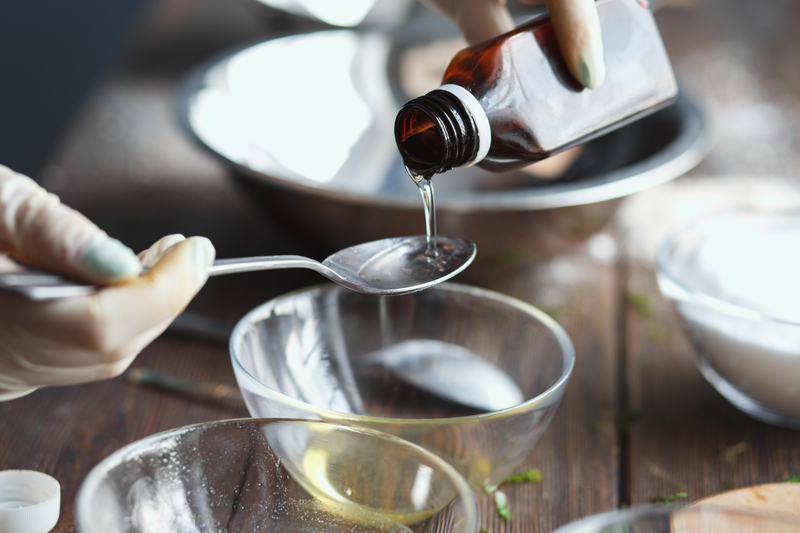Effortless and Effective Mould Cleaning for Window Sills
Posted on 26/08/2025
Effortless and Effective Mould Cleaning for Window Sills: The Ultimate Guide
Are those ugly dark spots on your window sills giving you a headache? Mould on window sills is a common yet unsightly problem, especially in areas prone to high humidity or poor ventilation. Not only does mould damage your home's aesthetic, but it can also be a health hazard, causing respiratory and allergy problems. Fortunately, learning how to clean mould from window sills can be easy, safe, and highly effective with the right information and technique.
In this comprehensive guide, you'll discover effortless and effective ways to remove mould from window sills, prevent its return, and keep your home fresh and healthy. We'll cover why mould forms, powerful cleaning techniques, safe products, and crucial prevention tips. Whether your sills are made of wood, plastic, or aluminum, this article is packed with SEO-optimized, actionable advice for keeping mould at bay!

Understanding Why Mould Grows on Window Sills
To tackle mould growth in the most effective way, it's important to understand what causes it. Mould is a type of fungus that thrives in damp, warm, and poorly ventilated environments. Window sills, especially those exposed to condensation, are perfect breeding grounds for mould spores.
- High humidity: Bathrooms, kitchens, and basements are especially prone to mould due to frequent moisture and steam.
- Poor ventilation: Closed windows and lack of airflow trap moisture, providing ideal conditions for mould.
- Condensation: Temperature differences between indoors and outdoors can cause water droplets to form on windows and sills.
- Organic materials: Wooden window sills are particularly susceptible because mould feeds on organic matter.
By addressing these root causes, mould cleaning on window sills becomes easier and less frequent over time.
Why You Should Not Ignore Mould on Window Sills
Ignoring mould doesn't just affect your home's appearance. Inhaling mould spores can lead to a range of health concerns, particularly for children, the elderly, and people with allergies or respiratory illnesses.
- Respiratory issues: Prolonged exposure can cause coughing, wheezing, sinus congestion, or trigger asthma attacks.
- Allergic reactions: Symptoms include sneezing, skin rashes, and eye irritation.
- Structural damage: Over time, mould can weaken wooden window sills, causing rot and structural issues.
It's crucial to act quickly and use the correct methods for effective mould removal on window sills.
Step-by-Step: Effortless Mould Cleaning for Window Sills
If you want to clean mould from your window sills with minimal effort and maximum results, follow these proven steps:
Preparations Before Cleaning Mould from Window Sills
- Wear protective gear: Put on gloves, a mask, and goggles to avoid contact with mould spores.
- Ventilate the area: Open windows or use a fan to improve airflow and prevent inhaling spores.
- Gather cleaning supplies: You'll need a bucket, scrubbing brush, microfibre cloths, and a safe mould cleaner (homemade or store-bought).
*Tip: Lay down an old towel or disposable covers to protect flooring and catch falling mould particles.*
Best Cleaning Solutions for Window Sill Mould Removal
There are several effective cleaning agents suitable for all types of window sills, including natural and chemical cleaners. Here are popular options:
- White vinegar: A natural, non-toxic killer of most mould strains. Mix equal parts white vinegar and water in a spray bottle.
- Baking soda: Combine a tablespoon of baking soda with water and apply as a paste for stubborn stains.
- Hydrogen peroxide: 3% solution is highly effective for deep-rooted mould. Use undiluted in a spray bottle.
- Commercial mould remover: Many cleaning brands offer specialised mould removers. Follow the instructions on the packaging for safe use.
Avoid using bleach on wooden window sills, as it can damage the surface and cause discolouration. For other materials, always test a small hidden area first.
How to Remove Mould from Window Sills: Step-by-Step Process
- Spray the cleaning solution: Generously spray your chosen solution over the mouldy areas. Ensure full coverage for 5-10 minutes to loosen the spores.
- Scrub gently: Use a soft-bristled brush or an old toothbrush. Be careful with wooden sills to avoid scratches.
- Wipe away residue: With a damp microfibre cloth, thoroughly wipe away all mould and cleaning agent residues.
- Repeat if needed: For stubborn spots, repeat the process or try switching between vinegar and baking soda for optimum results.
- Dry completely: Use a clean, dry cloth or paper towel. Moisture left behind can encourage quick regrowth of mould.
For areas with severe infestation, consider replacing the sill or seeking professional mould remediation services.
Mould Cleaning for Different Types of Window Sills
Materials matter. Here are important points for cleaning mould off different types of window sills:
Wooden Window Sills
- Use minimal water and gentle cleaners (preferably vinegar or baking soda).
- Scrub lightly to avoid damaging the wood's finish or grain.
- After cleaning, consider applying a wood sealant to protect the surface from future mould growth.
Plastic or UPVC Window Sills
- Most household mould removers are safe to use.
- Avoid abrasive scrubbing pads to prevent scratching the surface.
- Regular wiping with mild detergent solution helps prevent mould.
Aluminum or Metal Window Sills
- Can generally withstand chemical mould removers and mild scrubbing.
- Always dry the surface thoroughly to prevent rust or corrosion.
No matter the material, the key to effortless and effective window sill mould cleaning is prevention and consistent maintenance.
Natural and Chemical Mould Removal Solutions: Pros and Cons
Both natural and commercial products can be used to remove mould from window sills. Here's a quick comparison to help you choose the best option for your home:
- Natural Methods (Vinegar, Baking Soda)
- Non-toxic and eco-friendly
- Safe for families and pets
- Cost-effective
- May require repeated applications for heavy mould
- Chemical Cleaners
- Highly effective for stubborn or large infestations
- Fast-acting
- Can be harsh on certain surfaces (wood, painted sills)
- May require thorough ventilation during and after use
Choose the solution that best matches your health priorities, household needs, and window sill types.
Preventing Mould Growth on Window Sills: Top Tips
After the mould is gone, it's time to focus on long-term prevention of window sill mould. Here's what you can do:
- Increase ventilation: Open windows wherever possible or use trickle vents to reduce humidity.
- Install a dehumidifier: Particularly useful in bathrooms, kitchens, or rooms with poor airflow.
- Wipe away condensation daily: Use a dry cloth each morning to remove any water droplets from your windows and sills.
- Regular cleaning: Dust and wipe down sills weekly to catch early signs of mould growth.
- Check for leaks: Repair any faulty window seals or frames that allow water to trickle onto the sill.
- Apply anti-fungal sprays: After cleaning, spray an anti-mould solution every few weeks for ongoing protection.
Remember, the sooner you detect and treat mould, the easier it is to remove--and the less likely it is to return.

Frequently Asked Questions About Mould on Window Sills
Is window sill mould dangerous?
*Mould can exacerbate asthma, allergies, and respiratory illnesses. Infants, seniors, and the immunocompromised are at greatest risk. Always remove window sill mould promptly to reduce health hazards.*
Are there professional services for cleaning mould from window sills?
*Yes. If the infestation is extensive, or if you have recurring or toxic black mould (Stachybotrys chartarum), it's best to consult a certified mould remediation company.*
How can I prevent the return of mould on my window sills?
*Ensure good airflow, regularly clean condensation, use dehumidifiers and apply anti-fungal sprays after cleaning as a protective barrier.*
Are natural solutions safe for all window sill materials?
*Vinegar and baking soda are generally safe for wood, plastic, and metal, but always test a hidden spot first, especially on painted or varnished surfaces.*
Conclusion: Effortless and Effective Mould Cleaning for Window Sills
Mould on window sills can be a frustrating problem, but with the right strategies and cleaning routines, it's one you can easily manage. Remember:
- Identify the cause of moisture build-up to stop mould at its source.
- Use the right cleaning solution for your sill material and always wear protective gear.
- Clean mould promptly and regularly to protect your health and home.
- Prioritize ongoing prevention with good ventilation, daily maintenance, and anti-mould treatments.
With these effortless and effective window sill mould cleaning solutions, your home will not only look better but be a safer, healthier environment for everyone. Don't let mould settle--take action today!
Ready to banish window sill mould for good? Share these tips, and enjoy fresh, clean window sills all year round!




